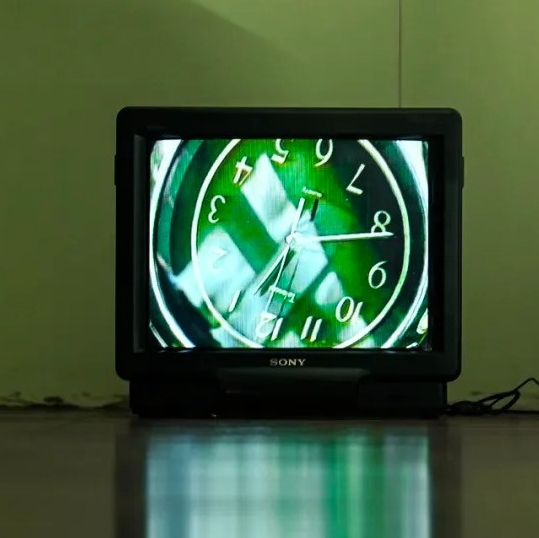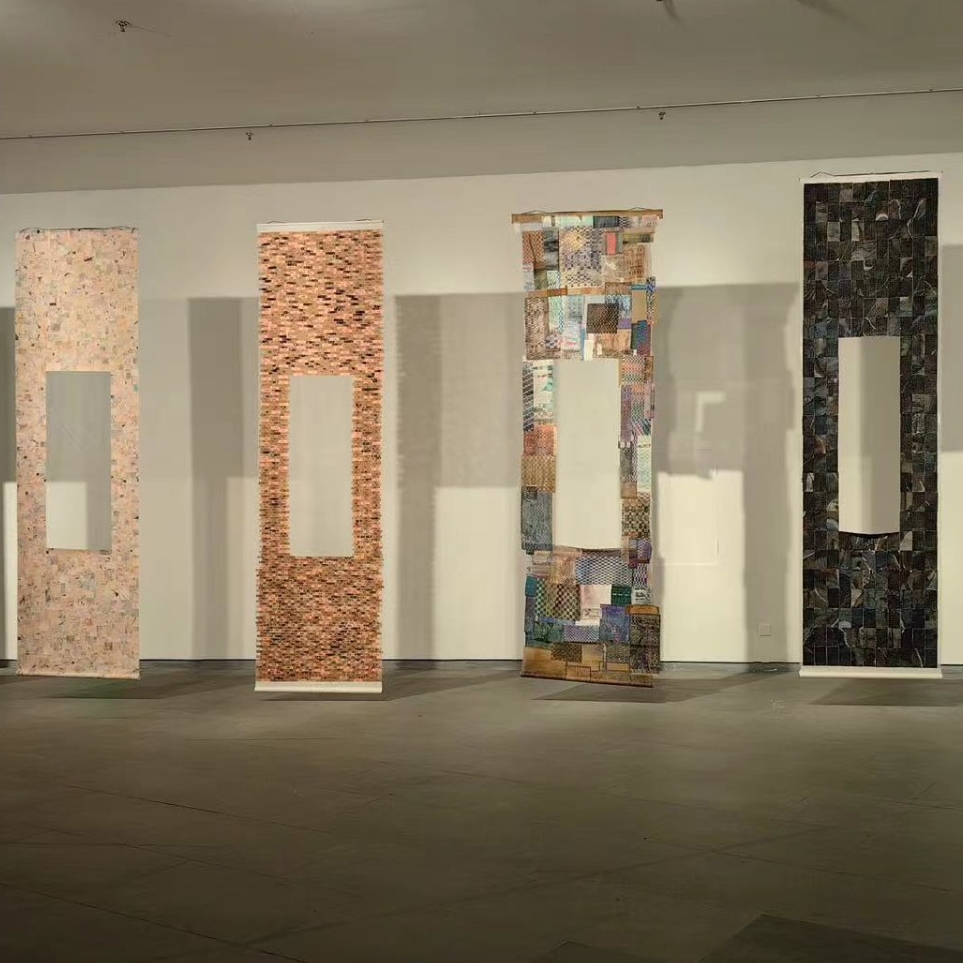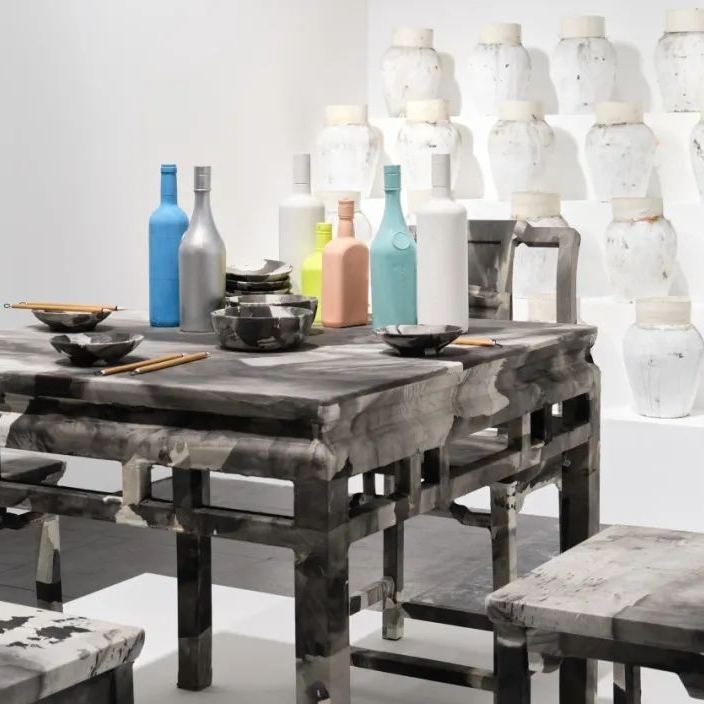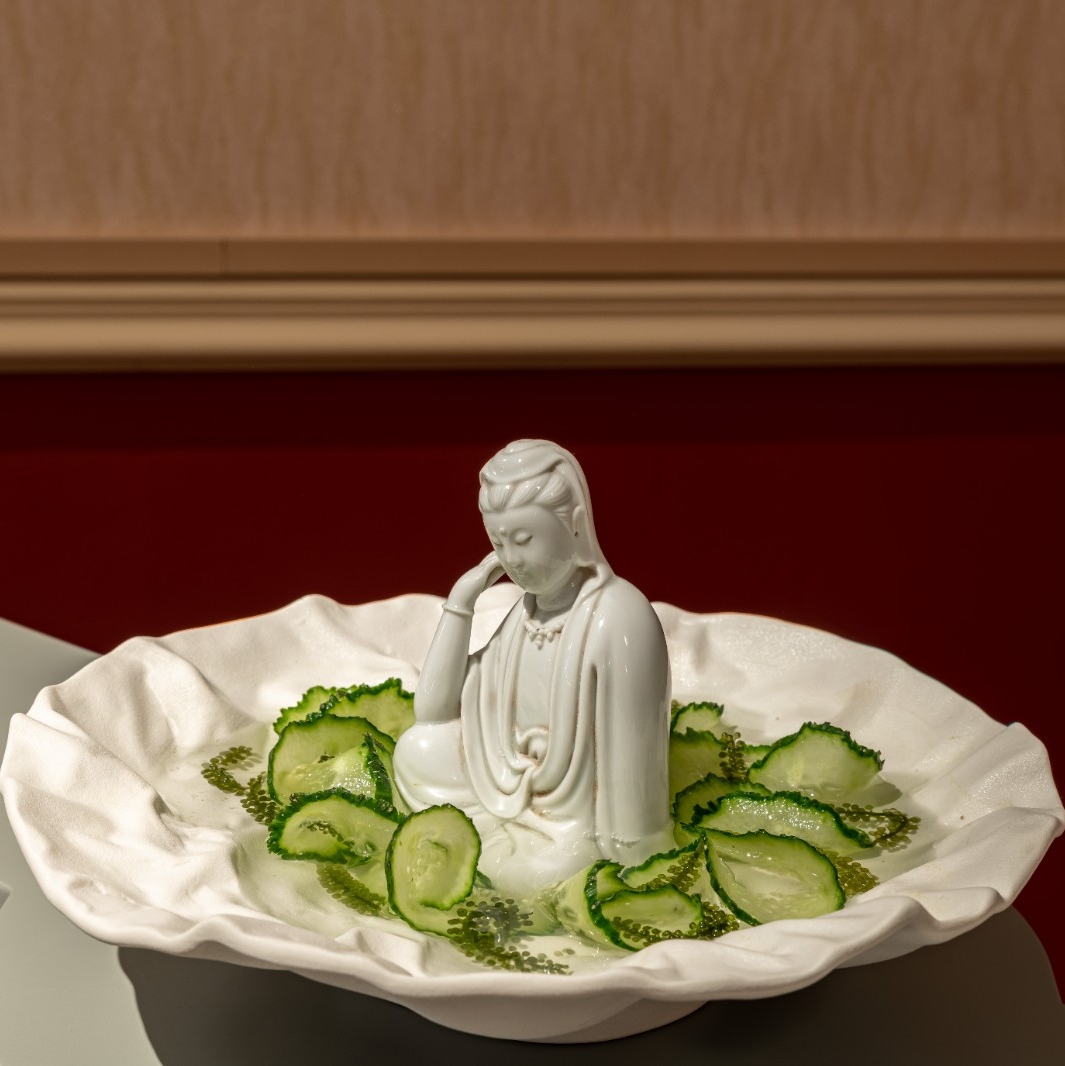
As one of the series of events of “Culture China”, “The Global Overseas Chinese Artists Exhibition” has been officially hosted by the He Xiangning Art Museum annually since 2020, and has become one of the major academic projects thereafter. Recently, “In Working: Women in Art Practice—Overseas Chinese Artists Invitational Exhibition” kicked off, which concentrates on the specific community of “overseas Chinese women artists” for the first time. Such a choice is in line with He Xiangning Art Museum’s development direction, namely, “taking the research of He Xiangning as the central focus, while being concerned with female art, promoting traditional culture, incorporating diverse thoughts for facing the future”.
As a great woman in modern Chinese history, He Xiangning shared various social identities such as a social activist and an artist. In this exhibition, the participating 16 overseas Chinese female artists also have diverse identities, such as overseas Chinese, second-generation immigrants, musicians, stage designers, founders of social organizations, educators, etc.. For many of them, being an artist is merely their second occupation. Li Beike and Liu Xiyan, who serve as the curators of the exhibition, stated in the interview that, the exhibition is expected to truthfully convey the working status of the current overseas Chinese women artists, revealing the unique creative energy of this community while being concerned with the challenges confronted by them during their artistic working lives. “Today’s discussion of women’s social identity lies not only in equality and empowerment, but also in reaffirming their creativity and distinction in social work. ”[1] As the Curators’ Forward claims, the exhibition starts with the notion of “in working”, intervening art production, social labor, social engagement, among other production links in specific and diverse practices. By doing so, the exhibition intends to discuss the diversity of social labor and the potential creativity behind it within a globalization context.


Exhibition View of “In Working: Women in Art Practice—Overseas Chinese Artists Invitational Exhibition”. Courtesy of He Xiangning Art MuseumI. Day-to-day Labor and Creative Possibilities
“Manual labor” has been practiced by a great number of female artists since the 1960s and 1970s. It has not only expanded the content of “elegant art”, but has also become a frequent artistic language practiced by female artists—let’s put it in a more accurate way—by artists with female consciousness. The nature of the “manual” is derived from intuition, languages, and characteristics. Moreover, it implies a set of frameworks regarding cultural traditions, social relations and values. On the one hand, the continuous practice and exploration of handicraft are related to tradition, emotion and individuals’ authentic feelings about life; on the other hand, it also reveals the significance of the repeated examination regarding the features, categories, and value of women’s labor and production in the changing social environment where women live.
In participating artist Beili LIU’s self-statement, she regards her creation as “labor-intensive works”. The so-called “labor-intensive” is embodied in the cheap and everyday materials, as well as a great deal of tedious and receptive labor that is required for the creation. In “Lure Series”, the artist uses a large number of silk threads and sewing needles—thousands of hand-made spiral spools are penetrated by needles pair by pair, while a red thread always connects different pairs of spiral spools, creating a complicated tension of different psychological elements and therefore triggering the shared humanity deeply rooted in everyone.

Beili LIU, “Lure”, Spacial Installation, Thread Roll, Sewing Needle, Size Variable, 2008-2021
Courtesy of He Xiangning Art Museum
The artist stated that “the seemingly mundane work by women is often an act of nourishment, offering and healing, which is the fundamental enabler that makes human existence and progress possible. What attracts me is transforming women’s work into a process of redemption and healing.” [2] Introducing “sewing” into artistic expression which also means making the obscured labor visible in an emotional way. The trivial and easily ignored labor can help lovers find each other and overcome social and cultural distance in legends. Also, it can gain nourishment and realize healing by calling for common humanity to bridge cultural differences and link back to China in reality.


Beili LIU, “Lure”, Spacial Installation, Thread Roll, Sewing Needle, Size Variable, 2008-2021
Courtesy of He Xiangning Art Museum
In CHANG Yuchen’s “Use Value”, the “simple labor” represented by housework, the “social labor” such as working in coffee shops and art museums, and the “complicated labor” represented by art labor, are displaced in “value” and “meaning” through a “Use Value Calculation Formula” conceived by the artist.

CHANG Yuchen, “Use Value (A Field)”, Installations, Mixed Materials, Size Variable, 2017-2021
Courtesy of He Xiangning Art Museum

CHANG Yuchen, “Use Value (A Field)”, Installations, Mixed Materials, Size Variable, 2017-2021
Courtesy of the artist.
“Use Value” is an experimental brand established by CHANG Yuchen in 2016, and every product of the brand is handcrafted by the artist. “The labor of the hands is converted into money, and the purchase and possession are regarded as love,” [3] So said CHANG Yuchen. The apron series presented in this exhibition is based on the artist’s reflections on housework.
The dislocation of value and meaning behind these aprons is not only the tension between the simple labor represented by housework and the artistic creations involving the artist’s mental effort, but is also an inquiry that is based on individual experience—how should we define the value of non-socialized housework which is usually regarded as care within the family?

CHANG Yuchen, “Use Value (A Field)”, Installations, Mixed Materials, Size Variable, 2017-2021
Courtesy of the artist.
As Betty Friedan has proposed in 1981 that the way of thinking that women develop when dealing with trivial problems in daily life and family relations, in most cases, does not form the theoretical thinking, which is substantially regarded as non-significant in day to day life. Neglecting one-half of the human experience also means ignoring one-half of the creative power. [4] What kind of creative possibility can be generated during the process of the solitary work that exists day after day and supports the operation of the whole society then?
II. Reflections on Cultural Difference and Their Productive Aspect
Participating artists such as Gayle Chong KWAN, Linda ZHANG, Susan Pui San LOK, Yeu-Lai MO, Alison KUO, Serena LEE are second-generation immigrants. They are generally sensitive to different cultural contexts and post-colonial issues, but their creative spectrums are far more than these topics. While Beili LIU and Hua JIN as the first generation of immigrants focus on the fusion of various cultures and immigration problems—these issues are not merely restricted to the interior of the overseas Chinese community. They either seek for resonation between diverse cultures, or conduct a long-term and flowing observation of other immigrant communities, and therefore reflect on the construction of their self-identities. As for CHANG Yuchen, Chun Hua Catherine DONG, Duoni LIU, Jennifer Wen MA, Alice WANG, Yiy ZHANG, SHEN Cai, chose to continually live and work abroad after their graduation and adopt a cross-country working style.

Jennifer Wen MA, “Threading the Sky”, Paper Sculpture, Spacial Installation, Dimensions Variable, 2021
Courtesy of the artist.
Specifically, whether it is women, migrant workers, mothers, artists, or immigrants who gradually forget their mother tongue, based on their local, gender and cultural experience of individuals, artists tend more to conduct detailed, pluralistic and dynamic observations and release their diversified understandings regarding the cultural difference and internal gender differences and their transcendental thinking.
Although Alison KUO and Yeu-Lai MO are both second-generation immigrants, they have carried out different grammatical translations on the food theme, which acts as an essential part of the culture, based on their individual experiences.


Alison KUO, “Chinese Cooking the American Way”, Book Collage, Silk print, Size Variable, Original Work created in 2018
Courtesy of He Xiangning Art Museum.
“Chinese Cooking the American Way” is a series of printed collage works by Alison KUO, showcasing the lost, deformed, regeneration, and the “productive aspect” of culture in the process of diaspora. The classic Chinese cookbooks published from the 1960s to the 1980s mainly served Western readers and Chinese immigrants who are curious about exotic cuisine. The illustrations and texts in the cookbooks are further deconstructed by the artist and hung in the exhibition hall like flags. Similar to the role of cultural identity in individuals, especially the second-generation immigrants, the audience can observe how Chinese food, which is separated from the motherland, has lost some of its traditions and added some elements of “untimely creativity”, thereby integrating into North American culinary culture.
Such a cultural deconstruction and collage lie in Alison KUO’s thinking regarding cultural identity. “In the U.S and Europe, ownership and individualism are frequently emphasized, and novelty can be confused with quality. While I studied ceramics in Jingdezhen, traveling in Shanghai, Xi’an, and Beijing, I realized that artists can occupy a place in this endless continuum of art production, and can use the sophisticated skills of many collaborators to create contemporary art. Culture can be seen as an ever-changing collage.”[5] Food culture is usually a concentrated reflection of the local culture. The artist simplifies re-standards, and prints another kind of food culture, together with the marketing and promotion of exotic food. By doing so, she has realized a political migration with a post-colonial flavor in a certain era by taking food as a surface of a specific culture.

Yeu-Lai MO, “All the Chinese I know”, Inkjet Print, 150 x 200cm, Original Work Created in 1997, Installation View
Courtesy of He Xiangning Art Museum.

Yeu-Lai MO, “All the Chinese I know”, Inkjet Print, 150 x 200cm, Original Work Created in 1997
Courtesy of the artist.
Yeu-Lai MO’s work is also related to food culture, but the artist chooses a humorous, poetic and potentially sad way to retrospect her entire childhood and adolescence working in the family restaurant. “All the Chinese I know” consists of calligraphy and printed banners, and the characters used in the calligraphy are unique simplified Chinese characters. “My mom helps us further simplify the Chinese characters, which makes it easier and faster to write down when we receive orders. This piece of work is a ‘list’ of extremely simplified Chinese…When I present this work, it is likely to be humorous, but it was actually a very sad piece. The background stories are about child labor, and childhoods lost in language and culture. ”[6] What behind Yeu-Lai MO’s works is individual narratives that intertwine with memories and emotions. Another piece of work “Service with a Smile” presents the depression and identity anxiety experienced by a second-generation immigrant teen girl.

Yeu-Lai MO, “Service with a Smile”, Photography, Giclée, Size variable, Original Work Created in 1996, Installation View
Courtesy of He Xiangning Art Museum.
It can be noted that the overseas Chinese identity and female identity consists of the primary concerns and the awareness of problems in the artists’ creation. In the process of exploring and sorting out individuals and history, the artist is also re-weaving and writing a micro-history of overseas Chinese.
Linda ZHANG’s “Your Future Heritage(s) of China Town” researches and deconstructs the China Town—a strong cultural symbolic architecture, to respond to the complex relationship between Chinese cultural identity and mainstream Canadian society. By doing so, the architecture of “China Town" therefore has a similar “hyphenated node” style for overseas immigrants.
Linda ZHANG, “Your Future Heritage(s) of China Town”, Architectural Installation, 370 x 305 x 83cm, 2018-2021
Courtesy of He Xiangning Art Museum.
From Linda ZHANG’s viewpoint, the core of choosing “China Town”, a Chinese cultural symbol shaped by the West, is to challenge the concept of “origin” in the West. “In the West, people stubbornly believe that everything has an unalterable origin, which is usually quite fixed and centered on the existence (as opposed to absence or time). If the alleged true origin can be traced and named, a thing can then possess a ‘real’ identity. If it is not the case, it is unreal and does not have a high value instead. In the East, I’ve observed that the concept of ‘origin’ is more dynamic. It is an endless generative process.”[7] By examining “China Town”, whose architectural forms lack true “origin” and is accepted by Western identities, the artist challenges the Western understanding of memory and heritage and further expands the meaning of the concept of “origin”.

Linda ZHANG, “Your Future Heritage(s) of China Town”, Architectural Installation, 370 x 305 x 83cm, 2018-2021
Courtesy of He Xiangning Art Museum.
III. Future-orientated Work
Whether reflecting on anthropocentrism and the prospect of the human future, or utilizing interdisciplinary working methods such as archaeology and anthropology, in terms of selecting creative themes, methods, and materials, overseas Chinese women artists are presenting transcendence and openness when exploring the possibilities of art and thought.
Duoni LIU, “Oops! I Dropped My Needle”, Transboundary Art, Performance, 36’19”, 2021
Courtesy of He Xiangning Art Museum
Susan Pui San LOK, “Lightness”, Three-screen Video, 20'06", 2012
Courtesy of He Xiangning Art Museum
As a first-generation immigrant, Hua JIN investigates and researches another group of Scottish immigrants, focusing on the interactive history of nature and themselves in Canada. The project originated from her long-standing interest in land and nature, and she realized that with the loss of young people, in the small town of “Dundee”, which has experienced generations of immigrants, the once conquered land was gradually back in the hands of nature. The Scottish immigrants are not the only protagonists of “Dundee”, the interaction between humans and nature has continued to be staged since the first generation of Scottish immigrants arrived in the early 19th century, leaving traces and memories on this land. Herein, the Scottish immigrants as a symbol of human beings, and their relationship with nature, have become the core of the artist’s concern and research. “The word Dundee shares two meanings in Scottish Gaelic—“Due” is a castle, which refers to humans’ desire for eternity; while “Dee” is a river in Scotland, and the flow of water means constant changes. Therefore, the name ‘Dundee’ is a paradox of human beings trying to resist constant changes of everything.” [8]By observing and presenting how one culture integrates into another, a perspective that transcends nations, races, cultures and generations is generated. Based on such shared emotions of human beings, the artist, therefore, has conducted a reflection on mobility and migration, history and memory, human existence and nature.

Hua JIN, “Dundee” Series, Photography, Giclée, Size Variable, 2016-2020
Courtesy of He Xiangning Art Museum.




Hua JIN, “Dundee” Series, Photography, Giclée, Size Variable, 2016-2020
Courtesy of the artist.
Such a perspective which is similar to human observation, while transcending female issues and even anthropocentrism, also appears in Gayle Chong KWAN’s “Anthropo-scene”. It applies the researching method of anthropological fieldwork, with both two-dimensional photography and three-dimensional sculptures appear in the form of occupying different volumes in space, and they are collaged with buildings and objects that are difficult to identify clearly in the image, which constitutes some mixed, blurry picture of the “Anthropocene.”
In the photographic panorama, the artist combines images of lost buildings in London with rubbish which has long been collected from the city to create a layered look of archaeological strata in the images. “Photography and installation emphasize the temporal nature of waste—as repositories of indestructible artifacts, they testify to the dominance of human influence and at the same time signify the past and changes.”[9] The artist seems to envision such a scenario: these indestructible objects, and buildings that have disappeared, are deposited under the surface, becoming “Anthropocene” memories and evidence of their past existence.


Gayle Chong KWAN, “Anthropo-scene”, Photographic Installation, Dimensions Variable, 2015
Courtesy of the artist.
The open nature of media also provides a transcendent willingness to work towards the future. During the pandemic, SHEN Cai, like most people, began to rely on online meetings for a long time to carry out her work. The creation of “No Different” was inspired by such a large number of virtual links. SHEN Cai summarized the series of works as “data sketching” —there are both realistic and digital virtual elements, to be precise, they are products in between. In the online teaching work, SHEN Cai was confronted with communication between people isolated by the screen, which prompted her to start thinking—when the images on the screen are just a few lines of binary codes existing in the virtual world, what is the relationship between this virtual identity and reality?
SHEN Cai, “No Different”, Painting Installation, Video, 35 x 27cm x 4, Video Size Variable, 2'14''/2'03''/2'08''/2'02'', 2020
Courtesy of He Xiangning Art Museum.
 SHEN Cai, “No Different”, Painting Installation, Video, 35 x 27cm x 4, Video Size Variable, 2'14''/2'03''/2'08''/2'02'', 2020
SHEN Cai, “No Different”, Painting Installation, Video, 35 x 27cm x 4, Video Size Variable, 2'14''/2'03''/2'08''/2'02'', 2020
Courtesy of the artist.
The Internet provides people with the convenience of online communication, and at the same time it also provides a vague middle ground embedded between “real life” and “virtual world.” SHEN Cai believes that it is this indefinable area that provides a habitat and development space for mankind to move towards “post-humanity.” “No Different” attempts to integrate real people and people living in the virtual world into a brand new image, a brand new human species. This new species has the following characteristics: for the first time, they can be erased of physical distinctions and thus have a unified “post-human” perspective, thus breaking down the confrontation, division and inequality caused by the “identity myth.”
Alice WANG’s “Untitled 2017” consists of three sculptures and video works. These untitled works do not simply explore materials and shapes. Through an interdisciplinary approach, Alice WANG has extensively researched and visited geological landscapes, monuments, scientific and technological facilities, including the Denali National Park in Alaska, the Qinghai-Tibet Plateau, the San Andreas Fault, the Arctic, Mount Kinabalu, SpaceX, Biosphere2, the Very Large Array, the Five-hundred-meter Aperture Spherical Telescope, and the Mayan Pyramids, so the work directly interacts with history, especially the history of science and technology, on a physical and conceptual level.
Alice WANG, Installation View of “Untitled” Series
Courtesy of He Xiangning Art Museum.
The stainless steel material is used to imitate the granite of the Jurassic period, the yellow beeswax is linked to the remains of Stonehenge, and the 30 cm meteorite iron is related to the pyramids of the Mayan civilization. The collision between ancient civilizations and other variable materials such as fossils, meteorites, metals, beeswax, etc., is combined with the juxtaposition of ancient civilization sites and modern technological buildings in video works, to achieve the artist’s pursuit of “the subtle sense of stage created by the separation of elements” and “the presence of diffusing sculptures, almost like a smell.”[10] The ancient and the modern are bridged with each other through the mythical and mysterious power hidden in the material elements, so as to raise metaphysical thinking about the material and the essence of existence.

Chun Hua Catherine DONG, “Meet Me Half Way”, Four-screen VR Video Installation, 3'04'', 2021
Courtesy of He Xiangning Art Museum.

Yiy ZHANG, “Lebenslinien- Feuerwerk”, Performance, Video, 0’50”, 2018
Courtesy of He Xiangning Art Museum.
Generally, “Overseas Chinese” and “Women” constitute the two-dimensional narrative of the exhibition, and they are scattered among the three exhibition sections of “Memory
/ Migration”, “Usual / Unusual” and “Chance / Change”. In the interview, Wang Huangsheng, Chief Exhibition Advisor, reiterated the characteristics of this exhibition—openness, tolerance and tranquility. The exhibition did not try to provide a standard answer, or to emphasize and establish new ethics, but to promote the display and sharing of artists in a decentralized way. Labor, identity, postcolonial, cultural migration, body, globalization, environment, community participation, history, virtual reality, post- humanity... With ingenious ways, 16 artists express their emotions and experiences, thinking and exploration, approval and doubt in the above broad issues, reflecting the thinking and practices by the overseas Chinese female art group “in working”, on individual and collective, daily life and society, countries and the world, etc..

Serena LEE, “Second Tongue”, Three-screen VideoInstallation, 2'40", 2019-2021
Courtesy of He Xiangning Art Museum.
Naormi Meijia WANG, “Ash Black Veil-identity 0.0”, Experimental Video Installation, 1'54", 2021
Courtesy of He Xiangning Art Museum.
“In Working” also points out a clue: from planting in the agricultural era, to labor in the industrial era, and further to the working practice of art production presented in the exhibition, as well as women’s “work” defined by different productive forces and eras are all brought into the discussion. They demonstrate such an effort with their works: to escape from the “either this or that” of the dualistic epistemology created by the Enlightenment, from seeking the sameness to understanding the difference itself, and even extending their thinking in more harmonious, diverse, inclusive and open possibilities beyond confrontation.
Notes:
[1] Exhibition Forward.
[2][3][5][6][7][8][9][10] Artist Interviews Provided by He Xiangning Art Museum.
[4] Betty Friedan, The Second Stage, Harvard University Press, April 1, 1998.
Text by Mengxi and trans. by Emily Weimeng Zhou
Edited by Sue/CAFA ART INFO
Courtesy of the organizer and the artists.



































